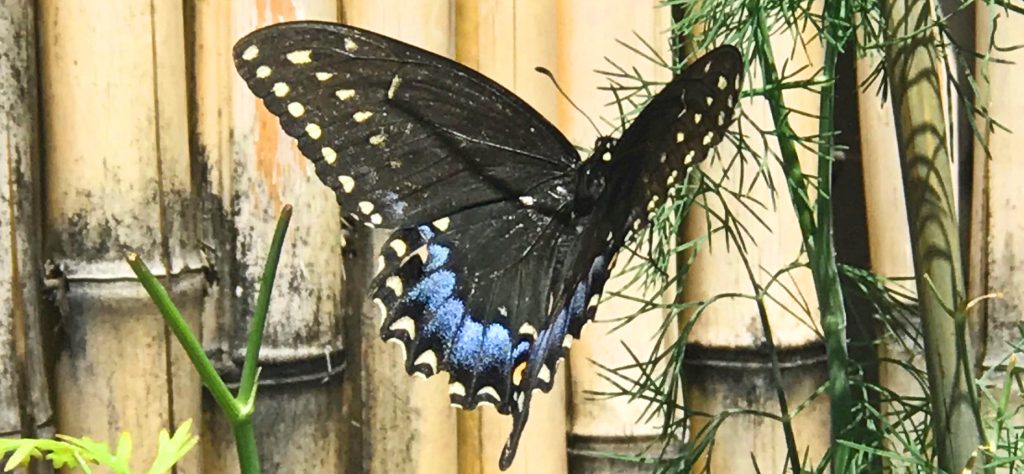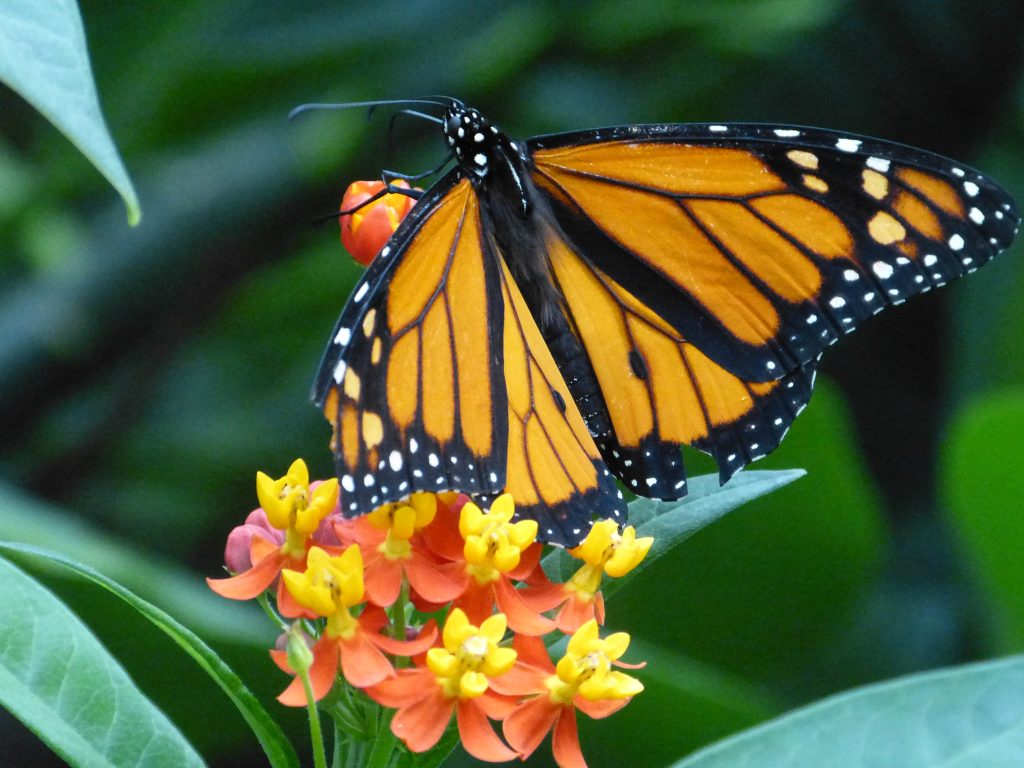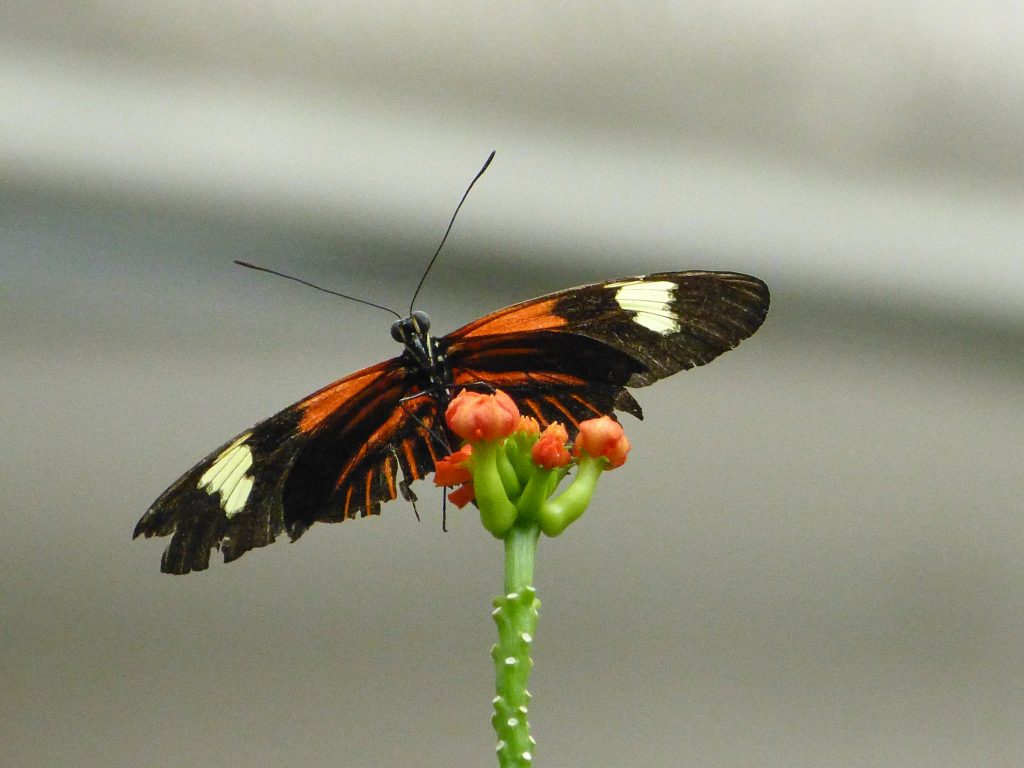Butterflies; Denver’s Neighboring Beautiful Winged Art Show
Up 36 to Broomfield, we are fortunate to be next to the famous Butterfly Pavilion. We see it as a photo up beyond compare and a rare treat. The butterflies might see it as a giant spring break in the jungle.  Black Swallowtail photo Lenny Lensworth Frieling
Black Swallowtail photo Lenny Lensworth Frieling
The Black Swallowtail (Papilio polyxenes) is a striking and widespread species of butterfly, known for its distinctive appearance and fascinating life cycle. This North American native is recognizable by its large, black wings adorned with prominent rows of yellow spots, and blue and red markings near the tail, which give it a majestic look. The males and females have slightly different color patterns, with the females often exhibiting more subdued hues.
Black Swallowtails undergo a complete metamorphosis, transitioning through four life stages: egg, larva (caterpillar), pupa (chrysalis), and adult butterfly. The eggs are laid on host plants, primarily those in the carrot family, like parsley, dill, and fennel. The caterpillars are uniquely marked with green and black stripes and possess an osmeterium, a defensive organ that emits a foul smell to deter predators.
As caterpillars mature, they form chrysalides wherein they undergo transformation. The emergence of the adult butterfly is a moment of particular beauty, revealing the magnificent wing patterns and colors. These butterflies are important pollinators, feeding on the nectar of a variety of flowers.
The Black Swallowtail not only contributes to biodiversity but also serves as a popular subject for study in schools and an inspiration for nature enthusiasts, symbolizing transformation and resilience.

The Famous Monarch Butterfly Migration Spans Generations! Photo Debi Dodge
The Monarch butterfly (Danaus plexippus) is renowned for its extraordinary migration, one of the most remarkable natural phenomena. These striking orange and black butterflies undertake a massive journey of up to 3,000 miles, traveling from North America to central Mexico and back. This migration is unique because it spans multiple generations; no single butterfly completes the entire round trip. Instead, successive generations are born en route, each continuing the journey of their predecessors. Monarchs are also known for their dependence on milkweed plants, which are vital for their lifecycle as it’s the only food source for their caterpillars. This incredible journey, combined with their vivid colors, makes the Monarch butterfly a symbol of resilience and beauty in the natural world. 
Monarch Multi-Generational Migration

This cutie is also called the Milk Weed Butterfly. We have encouraged milkweed propagation for years, and they do well in Boulder in addition to looking really cool.
Family Nymphalidae, commonly known as the Brush-footed Butterflies, is a diverse and widespread group of butterflies, encompassing over 6,000 species worldwide. This family includes many well-known butterflies, such as the Monarchs, Admirals, and Fritillaries. Characterized by their smaller front legs, which are brush-like and often not used for walking, these butterflies exhibit a wide range of colors and patterns, adapted for various ecological niches and functions like camouflage, warning predators, and mating.
The identification of Nymphalidae butterflies can be particularly challenging due to their immense diversity and the subtle variations in coloration and pattern across species and even within the same species. Many species exhibit sexual dimorphism, where males and females have distinct appearances, and some undergo significant changes in appearance between their summer and winter forms. Additionally, mimicry is common in this family, with non-toxic species evolving to look like toxic ones to deter predators, further complicating identification.
Photographic guides and regional checklists can be useful, but often, precise identification requires examination of minute details, sometimes only discernible under magnification or through genetic analysis. This complexity makes the Nymphalidae one of the most fascinating yet challenging groups for both amateur naturalists and professional lepidopterists to study and identify.
- Multi-published and syndicated blogger and author.
- University lectures at University. of Colorado, Boulder, Denver University Law School, Univ. of New Mexico, Las Vegas NM, and many other schools at all levels. Numerous lectures for the NORML Legal Committee
- Former Judge
- Media work, including episodes of Fox’s Power of Attorney, well in excess of many hundreds media interviews, appearances, articles, and podcasts, including co-hosting Time For Hemp for two years.
- Life Member, NORML Legal Committee, Distinguished Counsel Circle.
- Photographer of the Year, AboutBoulder 2023
- First Chair and Originator of the Colorado Bar Association’s Cannabis Law Committee, a National first.
- Previous Chair, Boulder Criminal Defense Bar (8 years)
- Twice chair Executive Counsel, Colorado Bar Association Criminal Law Section
- Life Member, Colorado Criminal Defense Bar
- Board Member Emeritus, Colorado NORML, and prior chair during legalization, as well as pre and post legalization
- Chair, Colorado NORML, 7 years including during the successful effort to legalize recreational pot in Colorado
- Senior Counsel Emeritus to the Boulder Law firm Dolan + Zimmerman LLP : (720)-610-0951
- Board member, Author, and Editor for Criminal Law Articles for the Colorado Lawyer, primary publication of the Colorado Bar Assoc. 7 Years, in addition to having 2 Colorado Lawyer cover photos, and numerous articles for the Colorado Lawyer monthly publication.
- http://www.Lfrieling.com
 Black Swallowtail photo Lenny Lensworth Frieling
Black Swallowtail photo Lenny Lensworth Frieling



















